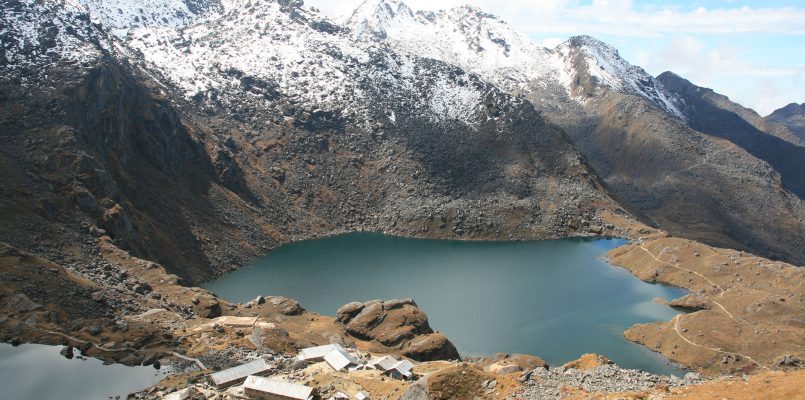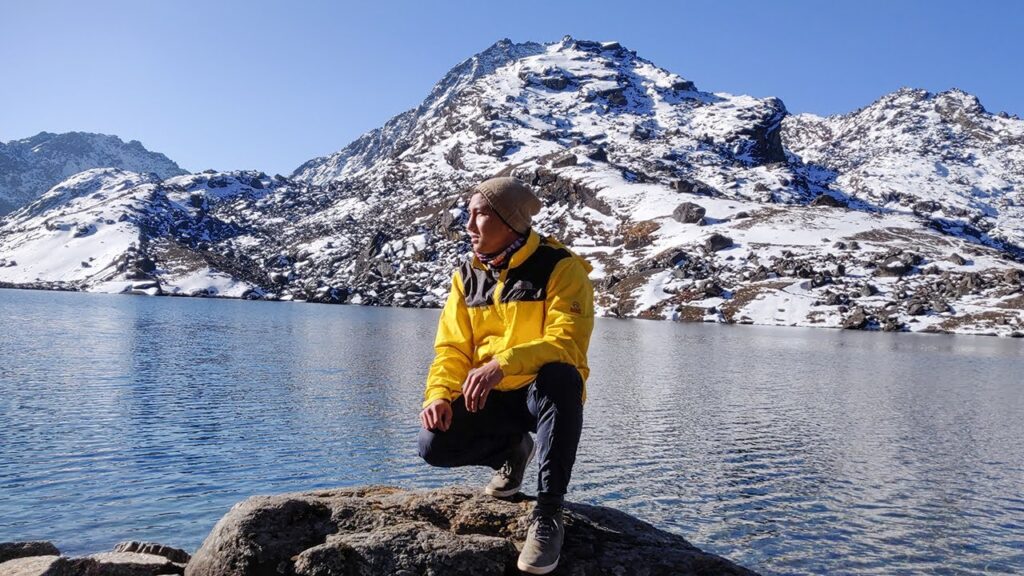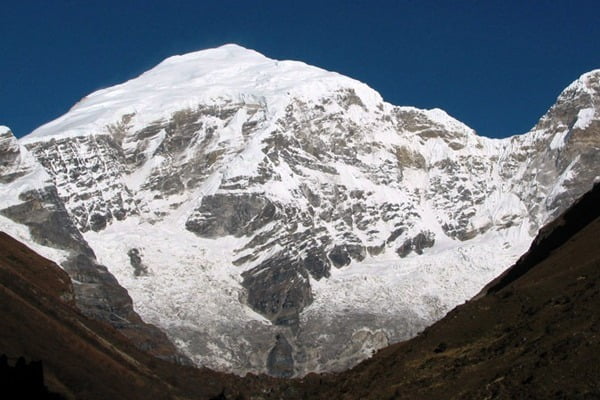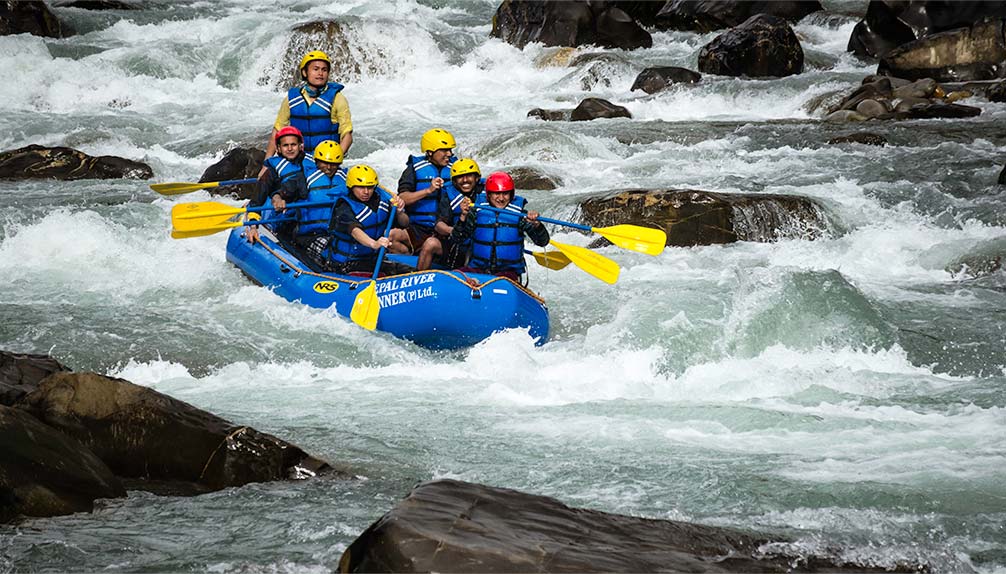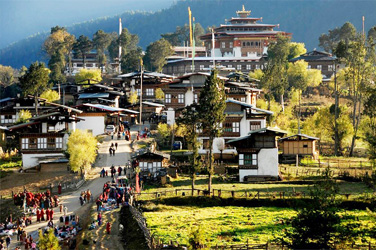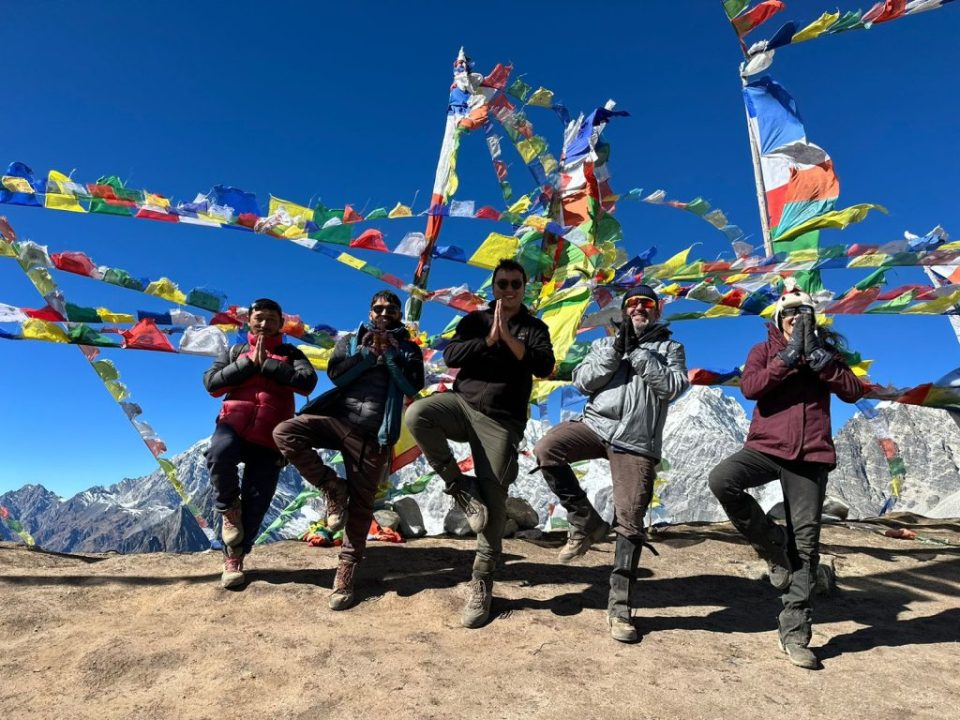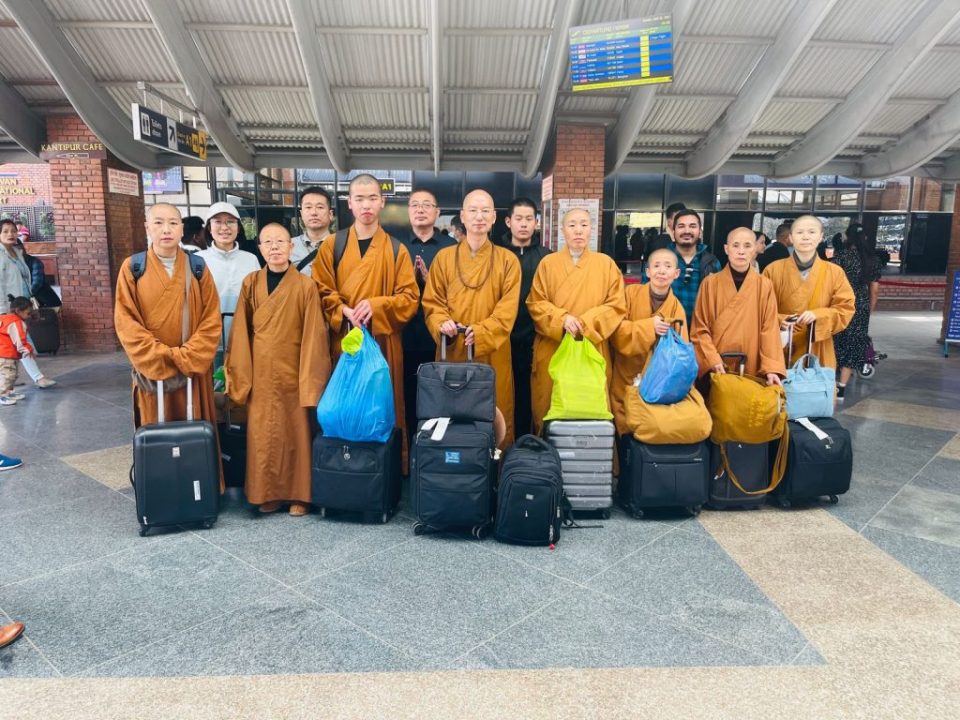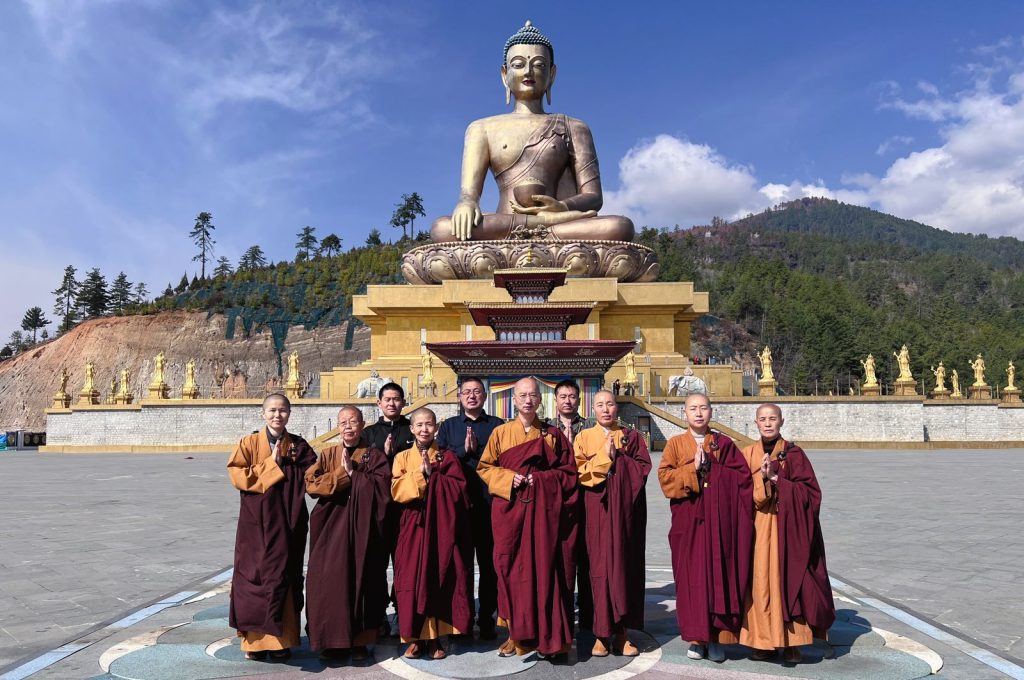Gosaikunda Trek
Destination
GosaikundaMax Elevation
4,300Fitness Level
ExcellentGroup Size
1-16Start-End
KathmanduTrip Introduction
Gosaikunda Trek is religiously vital and naturally richer activity in the northern part of Nepal fallen under Langtang National Park. Situated at an altitude of 4,380 meters, Gosaikunda is the name of a sacred Kunda (Lake) and the main source of the popular Trishuli River. Usually from January to June for about half year the Gosaikunda Lake changes into frozen form offering spectacular views to its visitors.
According to Hinduism, when the tremendous poison emerged from the sea, the lord god Shiva swallowed it to save the world from its dreadful influence. And to cool down his burning throat, he released a burst of freshwater with his powerful Trisul (holy Trident) forming a Gosaikunda Lake. Afterwards, the Lake is considered as a pure and fresh water in whole Nepal. During the festival, Janai Purnima thousands of Hindu devotees of Nepal and from India visit the place to pay homage to lord god Shiva. Taking a holy bath in this lake is believed to rinse your past sins, sorrows, and pains.
Gosaikunda Trek begins with a day drive from Kathmandu to Dhunche, the gateway for all Langtang Route Treks. Passing some wonderful Sherpa and Tamang Villages accompanied with the magnificent views of Langtang Range Mountains and with proper acclimatization, on the third day of this trek you will reach Gosaikunda Lake – the main destination of this package. The trail follows the Rhododendron, Bamboo and Pine Trees Forest which habitats lots of wildlife. Then exit the trek from Dhunche by driving back to Kathmandu.
Itinerary
Departure from : Kathmandu, Nepal
Arrival On : Kathmandu, Nepal
Day 1
Day 01: Arrive at Kathmandu airport and transfer your Hotel (1350m).
After arriving in Kathmandu, a representative of Jugal Holidays Pvt.Ltd will pick us up from the airport and take us to our hotel. In the afternoon, take a rest or visit our office briefing about the trip.
Day 2
Day 02: Drive from Kathmandu to Dhunche (2090m) 6 to 7 hour.
Early morning after having breakfast transfer your Bus station to start your journey towards Dhunche, along the bus journey you will drive through beautiful village and you will see snow Scrapped Mountain along the Langtang Himalaya and it will make your trekking become pleasant and touch your heart.
Day 3
Day 03: Trek from Dhunche to Thulo Syabru (2260m)
Early in the morning after breakfast trail slightly leads you to Thulo Syabru (2,260m). Thulo Syabru is a beautiful Sherpa and Tamang village from where you can observe the miraculous vista of Langtang Himal and Ganesh Himal and overnight here.
Day 4
Day 04: Trek from Thulo Syabru to Sing Gompa (3250m)
Morning breakfast in Thulo Syabru village the trail slightly goes uphill through beautiful Rhododendron, Bamboo and pine trees. Along the trail, you will pass several mountains village to reach Chandan Bari Sing Gompa and visit a cheese factory in the Langtang region of Nepal, where you will overnight today.
Day 5
Day 05: Trek from Chandan Bari Sing Gompa to Gosaikunda (4360m).
After morning breakfast in Chandan Bari sing Gompa, the trail slightly goes uphill to Gosaikunda via Lauribinayek. Along the trails past rhododendron and pine forest trees and vista of Ganesh Himal, Langtang Lirung, and Manaslu range, Hiunchuli and Tibetan peak are high lights of the adventure, you trek towards Gosaikunda (4,361m).
Day 6
Day 06: Trek from Gosaikunda to Sing Gompa (3250m)
After morning quick trips around Gosaikunda lakes, breakfast and trek downhill to Sing Gompa via Lauribinayek. Along the trail past rhododendron and pine forest trees and vista of Ganesh Himal, Langtang Lirung, and Manaslu range, Hiunchuli and Tibetan peak and overnight here.
Day 7
Day 07: Trek from Sing Gompa to Dhunche (2090m)
Morning breakfast in Chandan Bari Sing Gompa, trail directly drops you to downhill to Dhunche via the small village of Ramche and other villages along the route. Today your journey will be more enjoyable and beautiful, walking through rhododendron, pine trees and Himalayan Bamboo.
Day 8
Day 08: Drive from Dhunche to Kathmandu 6 to 7 hours.
Drive from Pokhara to Kathmandu and transfer your hotel.
Day 9
Day 09: Departure!
Our adventure in Nepal comes to an end today! Our representative will escort us to the airport approximately 3 hours before our scheduled flight. On our way home, we have plenty of time to plan our next adventure in the wonderful country of Nepal.
Route Map
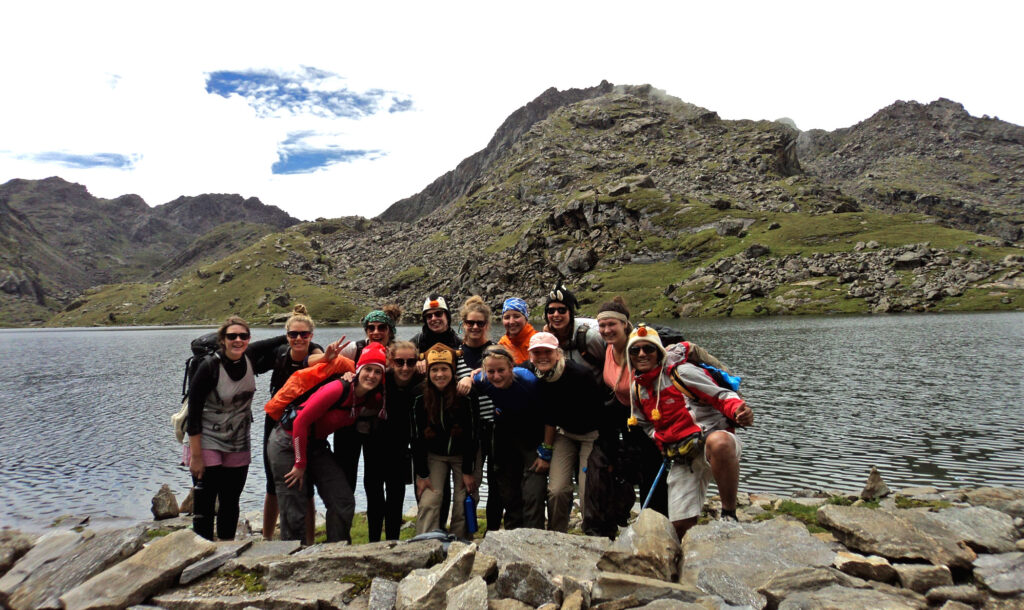
Altitude Map

What's Included
- Kathmandu to Dhunche by sharing bus/jeep.
- Twin Bed sharing teahouse/lodge/ accommodation during the trek.
- Everyday breakfast, lunches, and dinner while on the trek.
- An English speaking government license holder trekking guide.
- One porter for two trekkers.
- Langtang National Park Entry Permit.
- Trekker’s Information Management System Permit.
- Dhunche to Kathmandu by sharing bus/jeep.
What's Not Included
- Hotel Accommodation in Kathmandu.
- Breakfast, Lunch, and Dinner at Kathmandu.
- International Flight Fares.
- Tips/Gratitude for trekking staffs.
- Bar Bills like Mineral Water, Beer, Whiskey etc.
- Extra expenses occurred in case of landslides, political unrest, strike etc.
- Rest of all that are not mentioned in the cost includes list.
Equipment List
What to bring ?
General
Tailor Your Holiday
Everyone has their own preferences in terms of destination, journey time, and budget. As a result, sticking to our plan isn't necessary. We will create a personalized itinerary for you that includes accommodations, transportation, meals, and tour guides. We guarantee you the best Tailor-made Package because this is your trip. You have the option to personalize it, as your liking. Let us Plan together to make your Vacation worth it.
Fixed Departure
Why Travel With Us?
Secure Online Payment, No Credit Card Fee
Travel with Locals. Support Locals
Lifetime Deposit
Private & Tailor-Made Trips
24/7 International Support
Support Local Communities & Donate to Charity
All Inclusive Price
Secure Online Payment, No Credit Card Fee
The ideal season to travel
Spring (March, April, May):
Spring is the finest time to trek in the Langtang region after autumn. You will enjoy the long, warm and sunny days of this season. Daytime temperatures in the Langtang region range from 10 to 20 degrees Celsius (50 to 68 degrees Fahrenheit). The trail will be vibrant this season because it is Rhododendron season. Along the journey, you’ll see some wildflowers.
Summer (June, July, August):
The hottest month of the summer, as well as the beginning of the monsoon season. On sunny days, the temperature in the lower regions will remain constant at 30 ° C (86 ° F). However, as you ascend, the temperature begins to fall by around 12 ° C (52.36 ° F) in July. Because of the rain, the route is slippery with leeches, beetles, and earthworms. There is also the possibility of road closures due to landslides. However, you can also enjoy the greenery throughout the trail. Mountain views can also provide a clear view. If you are a devotee and want to have a dive in Gosaikunda, August is the time. Jani Purnima falls on full moon of August (18-19) and during Jani Purnima thousands of devotees visit Gosaikunda to do puja and to have a dip.
Autumn (September, October, November)
Autumn is the best season for trekking because the skies are clear and blue. You may feel cold in the mornings and at night, but the temperature ranges from 10°C to 15°C (50°F to 59°F) during the day. You will have the best trekking memories if the temperatures are bearable and the weather is stable. The rainfall is low during this season, and the scenery is stunning.
Winter (December, January, February)
December to February is the winter season. The region is experiencing snow and cold, with daytime temperatures ranging from 6°C to 9°C (42.8°F to 48.2°F). The nights, on the other hand, are much colder, with temperatures dipping below zero degrees. If you go trekking during this season, you will discover that it is less crowded, but you will have to struggle with the snowfall. While trekking, you must proceed with caution. Gosaikunda trekking in this season is risky as well as you might not get good visibility of mountains due to the fog, cloud, snowfall and the lake also get frozen.
Drive to Syabrubesi
- The Distance between Kathmandu and Syabrubesi is 45.7kms.
- Traveling to Dhunche by jeep will take around 6-7 hours.
- The route to Dhunche from Kathmandu is Naubise – Galchi and lastly Dunche.
Altitude sickness
Gosaikunda Trek is one of the most cherished and sought-after treks of Langtang region, on every trekker’s travel list. All most all the trek in Langtang region is located in the beyond the altitude of 2,500m and altitude sickness is the sneaky monster that sometime attack even the fittest trekkers beyond 2500m (8,000ft).
As a result, preventing altitude sickness on the Gosaikunda trek and remaining healthy throughout the trek should be your top priorities. With lower air pressure and lower inspiratory oxygen pressure, you’ll be hiking into the high-altitude zone. Acclimatization is the process of progressively becoming familiar with the new climate or changing environmental conditions. Almost everyone going quickly from lower to higher elevations requires altitude adaptation.
At elevations beyond 2,500 meters, AMS symptoms can be detected like:
- Increased breathing.
- Increased urination
- Restless sleep.
- Periodic breathing at night because of altitude.
- Dehydration.
- Shortness of breath.
- Extreme fatigue.
- Respiratory failure.
- Cerebral edema.
- Coma
To guarantee that the condition does not worse, certain precautions should be taken. However, if the symptoms increase, it may be necessary to return to a lower height and seek medical assistance.
- Walk slowly and gradually, as our bodies require time to adjust to the oxygen level. At least one day of acclimatization rest is required for high altitude trekking, and you should go as high as possible before returning to a lower height for the night.
- To gain strength stamina for your Gosaikunda trek, you should undertake various strength training exercises such as running, cycling, jogging, push-ups, and going to the gym.
- The greatest remedy is to always stay hydrated. On your walk, instead of drinking cooled water, drink warm water and avoid alcohol, cigarette and tobacco. You should also eat a balanced diet for strength
- Before traveling to an altitude greater than 3000 m, you must properly acclimate. If your body displays any signs of altitude sickness, you must either stop immediately where you are or consider descending to lower altitude.
- Bring a Diamox subscription with you on the trek because it is the most effective altitude sickness medication. However, you should consult with your doctor to see whether it is beneficial.
Things to known before travelling to Gosaikunda Trek.
Especially for trekkers, it is very necessary to hydrate your body at a higher altitude than in lower elevations to avoid dehydration and altitude sickness. Lack of fluid can be the main hindrance during the trek. You should hydrate your body with at least 3-4 liters of water on a daily basis (Tea, soup, or normal drinking water).
Getting water in Gosaikunda trek is not difficult but getting safe drinking water is. Throughout the trek, you will come across tap and spring water, but it is not safe to drink without purifying it. You can buy the plastic bottle water in the teahouses but get expensive as you climb in the higher altitude, and it causes pollutes the local ecosystem, therefore we recommend you to use a Reusable water bottle or water pouch favorable for both hot and cold water.
During this trek you may have to pay from 1$ to 2$ (at Gosaikunda) for a sealed bottle of water. Here are some ways that you can use to make the water drinkable.
- Boiled water
Boiling water is the best way to purify the water. As we are climbing to a higher altitude you need to boil the water for about 3-minute and season it with a pinch of salt before drinking. You can get free cold water in the teahouse but for boiled water, it cost around 1-1.5$ per liter and 2$- 5$ for large pot.
- Purification tablets or electrolyte powder.
Purification tablets like chlorine or iodine tablets are commonly used tablets by trekkers to disinfect the water. 1 tablet is enough for a liter of water. It takes around 30 min for the tablets to dissolve and become drinkable. Water purify by tablets may leave a taste in your mouth.
Electrolyte powder is another option. Electrolyte powder is a better way to purify water than tablets because electrolyte powder contains minerals such as salt, Potassium, Magnesium, which are important for your body during the trek. These tablets are available at any pharmacy in Kathmandu.
- UV Light water purifier/ SteriPEN.
It is a simple, effective, economic and environment-friendly way to purify water. It kills the bacteria and virus within 10 sec by exposing them to ultraviolent light using Steripen, without changing the flavor of water. You can buy this SteriPen online. This is highly recommended means of purifying water.
Electricity and Internet facility at Gosaikunda.
Electricity facility.
All the whole Langtang region is relay on solar power electricity.
Though some of the area of Langtang region close to town area (Dhunche, Sing Gompa) is powered by hydroelectricity, but most of the area of Langtang Region is powered by solar electricity which is enough to light bulbs in the room and charge small devices for them. So, there won’t be a charging socket in your room during the trek to Gosaikunda. There is a common place for charging usually in dining area. Using electricity to charge device will charge you some dollars (2-4$). So, it’s better to bring power bank that is sufficient to charge you device during your whole trek.
Internet Facility and Service
Internet and network facility is needed to contact your family, friends, employee, to post updates and upload photos during the trek.
Langtang region does have internet access, but it lacks stable connection due to its altitude. Most of the lodge/ teahouses in the trail to Gosaikunda has Wi-Fi availability. Some provide it free of charge and some charge an amount. However, you can connect to the internet via. your cellular network’s data package.
Both NCell and NTC cellular service has been providing the network and internet facilities in Langtang Region. You can buy the NCell or NTC sim card from the stores either in Kathmandu for 1$. By taking data packages you can use the internet from NCell and NTC up to Gosaikunda.
NTC cellular service most preferred over NCell. NTC provides good service and signal connectivity throughout the Langtang region, comparison to NCell.
In comparison to Wi-Fi of lodge/teahouse, the cellular data internet is much faster.
| Buy NTC data package
Dial*1415#
|
Cost of data package in NTC:
-14GB=7$ (Valid up to 28days -30GB=15$ (Valid up to 90 days) |
Check balance
Dial *1415#
|
| Buy NCell data package
Dial *17123# and select.
|
Cost of data package in NCell:
-15GB=10$ -25GB= 12$ (Valid up to 30 days) |
Check balance
Dial*101#
|
Document needed to buy a sim card.
For foreigner = 1 passport size photo, Passport photocopy, or valid identity card.
For Nepali = 1 Passport size Photo, Photocopy of Citizenship.
Some useful tips to reduce the use of electricity.
- Extra batteries for the camera.
- Power bank with 5000-10000mAh.
- The solar charger and solar lamp (LuminAID Lamp).
- As possible less usage of a device with low brightness, GPS, and WI-FI off.
Essential Backpack items for Gosaikunda Trek.
The bag of a trekker also reveals the trekker’s level of experience. A good trekker should be a smart backpacker. You should be pre-prepared for the things that you need in the trek.
Here are some of the things that you need to take with you for the trek.
Travel documents
- Airline tickets with the itinerary.
- Travel insurance policy documents.
- Valid passport.
- Copies of passport.
- Passport-sized photos.
- Nepalese cash.
- Travel permits.
Clothing
- A pair of waterproof trekking shoes or hiking boots.
- A pair of flip flop slippers or running shoes.
- 2 sets of thermals (leggings and tops)
- 2-3 pairs of hiking long sleeve shirts or tops.
- Pairs of hiking shorts and pants.
- Fleece jumpers or a set of tracksuits.
- Good quality windproof down jacket.
- Lightweight waterproof rain jacket and pants.
- Neck gaiter, leg warmer, and packet of pocket hand warmers.
- 4-5 pairs of quick-dry socks, underwear, sports bra.
- Pair of inner and outer gloves.
- Knitted Hat, sun cap, beanie, or bandana.
- Glacier Sunglasses and eyeshade.
Trekking equipment
- Waterproof trekking bag of 40-50liter and Rucksack of duffel bag (if your backpack is not enough for all your item and need a potter).
- Reusable water bottle (both hot and cold) of at least 1-2litre.
- A sleeping bag and sleeping bag liner.
- Trekking stick/ poles.
- Pair of ice traction (crampon)- If you are travelling in winter.
- Raincoat (favorable for both snow and rain)
- LED Headtorch or solar lamp (LuminAID lamp).
- Stuff sacks, plastic bags.
- Plug adapter, Charging appliances, power bank, batteries.
- Pocket knife.
- Travel Wallet.
Toiletries
- Rolls of Toilet paper, wet wipes, and tissue.
- Medium-sized quick-drying towel.
- Toothbrush and toothpaste.
- Hand sanitizer.
- Sunscreen, lip balm, body lotions.
- Portable mirror.
- Shampoo and soap.
Personal First Aid Kit
- Antibiotics
- Painkillers, Paracetamol, ibuprofen, aspirin, Nicole
- Sanitary pads
- Anti-inflammatory spray.
- Anti-Nausea tablets.
- Anti-diarrhea pills or power.
- Altitude sickness tablets.
- Water purifying tablets or electrolyte powder.
- Mosquito and Insect Repellent
- Salt or anti leech oil (If travelling in rainy season, July- Aug)
- Earplugs
You can buy or hire trekking cloths and equipment in Kathmandu. If you are buying it, you have to allow an extra day for shopping; however, if you are hiring it, you must inform us in advance so that we can arrange it before your arrival in Kathmandu. This way you can reduce the weight of your luggage and save time and money.
Branded trekking clothes and equipment are available around Thamel area in a reasonable price.
Accommodation, Meal, and Transportation
Accommodation
We will accommodate in star hotel during our stay in Kathmandu. In Dhunche, we will stay in hotel. For the rest of the stop, we stay at lodges or teahouses.
Meal
During the trek, we will provide you three-time meals. You can choose from the given menu.
Breakfast– French toast, Cornflakes, Cereal, Pancakes, Gurung/ Tibetan Bread butter, Eggs, Oat meal, Tsampa porridge, Tea etc.
Lunch– Dal Bhaat set (Rice, vegetable curry, meat curry, Lentils, Tomato Chutney, Salad, Papad), Vegetable noodle soup, chicken noodles soup, Mushroom garlic soup, Fried noodles, Mo: Mo, Fried cheese Potato, Fried rice etc.
Dinner– Dal Bhaat set (Rice, vegetable curry, meat curry, Lentils, Tomato Chutney, Salad, Papad), Mo: Mo, Fried noodles, Spaghetti, Thukpa, Pizza, Fried Potato, Fried rice etc.
Besides these, there are a variety of other options of food. You can buy from your own pocket.
Transportation
By Bus- From Kathmandu airport to hotel at Kathmandu and vice-versa.
From Kathmandu- Dhunche.
From Sundarijal to Kathmandu.
By Air- Flight to Nepal.
Guide and Staff Arrangements
Throughout the trek, all your activities will be handled by our well-qualified and professional staff. We will do all the escorting. We are providing you a highly experienced and licensed local guide with fluent English speaking and has excellent communication skills. We will accompany you from Kathmandu and guide you all the way to Gosaikunda. Each group of 4-5 trekkers will be assigned an assistant guide, as well as a porter for two trekkers (2*15kg =30kg). If your luggage weight more than 15kg you will be provided a porter individually but you will be charged of 2 people.
All our lead guide, assistant guides, and potters are well professional and experienced. So, we hope for your respect and cooperation with us throughout the trek.
A typical day on the Gosaikunda Trek.
Every day will begin with the ringing of your alarm clock at 6 a.m. and a knock on your door from your guide with the invitation of breakfast. Get up, have breakfast, pack your backpack and get ready to start your day’s walk by 7 a.m. We need to start our trek early to avoid the scorching sun as in midafternoon the wind gets stronger compared to morning in higher altitude.
You’ll wander along the Rhododendron, Maple, Pine and Oak Forest trail enjoying the scenery, clicking photos, creating memories, passing by other travelers, interacting with your guide, hearing each other’s stories. Lunch will be served at a local teahouse in the late afternoon (1-2 am). Having lunch and an hour of rest, we will proceed to the day’s final destination as per the itinerary. On arrival at the destination, check into your accommodation. Get freshen up and some rest. As every teahouse where we stay has a large common dining area with a wood- burning stove in then center, there you will get to meet other travelers. You can sit there, laugh at each other stories, play cards, sing songs, play music, and have a good time. This will help you forgot all the tiredness of the day. Later at the evening you will have your dinner together. After dinner, your guide will give some short briefing about next day’s trek regarding when you must get up, when we have to start our trek next day, where we will stay the next day, how many hours we have to walk and so on.
In this trek you will walk for minimum of 4 hrs to maximum 8 hrs in a day. You will walk along the Rhododendron and Oak Forest. At night enjoy the view of sparkling stars floating in the clear sky above the freezing cold wind. You will have the majestic view several peaks such as Langtang Lirung, Yala Peak, Naya Kanga, Yubra Himal, Jugal Himal and other peaks. You will have a breathtaking view of freezing cold Gosaikunda Lake, Bhairav Kunda, Surya Kunda. Every stop might not be iconic but these 5 days trek to Gosaikunda will give you unforgettable emotions. Your hard walk will be paid off on reaching the destination with lifelong memories.
Nepal Tourist Visa and permits details
Visa procedure.
To travel Nepal, you’ll need a tourist visa that is valid for the period of your stay in Nepal. Better, if you have a tourist visa valid for at least 2 months because anything can happen during the trip and staying in Nepal after your visa expires would result in you paying a penalty. Apply for a visa at your nearest Embassy of Nepal or obtain an On-Arrival visa at immigration in Tribhuvan International Airport, Kathmandu. But better to contact your nearest Nepalese Embassy.
Here are the documents that you need, to apply for the tourist visa.
- The Tourist Visa Application Form for Nepal (Fully completed online and printed)
- Original Passport with at least 2 blank pages and validity of at least 6 months.
- Photocopies of your passport’s personal information page.
- At least 2 recent passport-sized photos of yourself with white background.
- Proof of accommodation in Nepal.
- Valid travel and return flight tickets.
- A bank statement from the last 3 months with a minimum closing balance of NPR2,00,000.
- Receipt of the visa fee for Nepal.
Note: Our trip is of 9 days so apply for 15 days visa cost USD 30. If you want to extend your stay in Nepal, apply for 30-day visa that costs around USD 50.
Entry permits and Requirements
Gosaikunda lake lies under Langtang National Park. So, to walk over the National Park you have to take some permits from the Government of Nepal. The Entry permits that you need for the trekking in the Langtang region are;
| Trekking permits | Foreign Nationals | SAARC Nationals | Nepali Citizens | |
| 1 | Langtang National Park Permit. | NPR 3,000 per person per entry + 13% vat.
(Approx. 34$) |
NPR 1,500 per person per entry +13% vat
(Approx. 15$)
|
NPR 100 per person per entry +13% vat
(Approx. 1.5$)
|
| 2 | Tourist Information Management System card.
(TIMS Card) |
NPR 1,000 per person with a guide (GT) and NPR 2,000 for solo trekkers (FIT) | NPR 300 per person with a guide (GT) and NPR 600 for solo trekkers (FIT)
|
-N/A |
Note: You can get both Langtang National Park Entry Permit and TIMS Card from Nepal Tourism Board in Bhirkuti Mandap, Kathmandu.
For the issue of TIMS Card, you need at least 2 members, accompanied by a licensed guide.
For more information about TIMS Card here the link.
If you are travelling from travel/trekking agency your agency will arrange all the Permits.
Documents required to get the permits.
- Complete the permit form with your passport details and tour details (Trekking area, Entry and Exit date and point, Route of Trekking, Emergency contact information for Nepal and your Home country).
- 4 Passport size photo.
- 4 Photocopies of passport personal information page.
- Copy of Travel Insurance policy to obtain TIMS card.
Travel Insurance
Trekking in Nepal is an adventurous and occasionally dangerous activity, especially at high altitudes. Trekkers must have travel insurance before visiting Nepal for trekking. During these 9 days trip of Gosaikunda trek, you may encounter a physical injury, illness or an unexpected accident and you will be responsible for all medical expenses and losses.
So, you need to have a travel insurance that will cover all our risk up to the altitude of 4,380m (Gosaikunda).
You need to choose an insurance policy that cover all of your possible risks from the start of your journey to your final destination. The following threats should be covered by your travel insurance:
- Cancellation of Domestic and International flights.
- Lost and stolen of baggage and passport.
- Hospital and Medical expenses (physical injury, Acute Mountain sickness, Altitude sickness, sudden accident)
- Emergency rescue such as Helicopter cost.
- All high-altitude trek dangers up to 4,500m.
You need to buy your travel insurance wisely so that if in case you come across any such incident, your travel insurance will bear it.
You can have your travel insurance in your home country or in Nepal also.
Responsible Travel
Gosaikunda is one of the holy lakes, scared to both Hindus and Buddhists as well as rich in natural beauty. It has a great value both naturally and religiously. All travelers should travel responsibly. Langtang region also touch the border of Tibet region of China so, majority of people in Langtang region practice the Buddhism and Tibetan culture.
You have to respect the local people, their culture, religion and try to limit any negative activities that will impact their local culture and environment. You can learn some Nepali greetings words to exchange greeting respectfully. We expect you to properly dispose the plastic garbage (food wrappers, plastic water bottles) around forest and lakes. You might encounter many rare species (Himalayan black bear, Himalayan Tahr, Red Panda and Assam Macaque) on the way to Gosaikunda, avoid disturbing them. While visiting the monasteries you have to follow the norms of the monastery. Ask for permission before entering and to click photo in any monasteries.
Your responsible travel will help Nepal achieve long-term sustainable tourism
FAQ’s
Why to travel Gosaikunda lake?
Gosaikunda lake is the famous holy pilgrimage site of Lord Shiva. It is a short and easy trek which provide you the experience of mountain trek, feel of alpine zone, trek to a religious site, view of Himalaya, and learn the Buddhist and Tibetan culture You will definite won’t regret going Gosaikunda lake. It is a combined package of budgeted, facilitated, religious and adventurous trek.
In how many days can we complete Gosaikunda lake trek?
The Gosaikunda lake trek can be completed in as short as 5 days to long as 12 days.
When is the best time to do Gosaikunda lake trek?
If you are a nature lover, Autumn season/ Mid-September to mid- November is the best time to do Gosaikunda lake trek. The weather is warm and stable, sky gets clear and you will get to see the alluring view of green landscape and snow-covered mountains.
But if are snow lover, winter season/January is the best time to travel because it is the early time of winter. You will get to experience light snowfall and the trail will be covered in light snow, making the walk easier.
And if you are a religious person, you should visit Gosaikunda around 10th of August. On August 10- Janai Purnima, thousands of devotees visit Gosaikunda for puja and bath. During Janai Purnima, a big “mela” happen in Gosaikunda. If you are not performing the puja, simply looking at the devotees is pleasurable.
Will I gain AMS during the Gosaikunda lake trek, even if am a frequent trekker?
Gosaikunda lake is on the altitude of 4,380m and Acute Mountain sickness is the sneaky monster that sometime attack even the fittest trekkers beyond 2,500m (8,000ft). So, it is possible you to gain AMS during the Gosaikunda lake trek.
Even if you are a frequent trekker, sooner or later depending on your health condition and your previous trek altitude history, you might gain AMS. You might gain AMS much later than other newbie trekker. So, you have to balance everything to make your body able to tackle altitude sickness. For that you have to intake sufficient amount of liquid and if needed acclimatize properly.
What is the Emergency medical facility/ availability in Gosaikunda trek?
There are local heath posts on the way to Gosaikunda lake, but no advanced hospitals. In Dunche there is a government hospital. If you require any emergency medical treatment, Heli rescue evacuation is available.
What is the available infrastructure for Langtang valley trek?
Transportation– If you are a solo traveler, you can take a local bus from Ratna park to Sundarijal, which depart frequently in the interval of 10 min. It will take you to your trek’s starting point. And when to get back, take a local bus from Dunche or Sybrubeshi, it will take you directly to Kathmandu.
Drinking water– Tap water and spring water are easily accessible, but must purify it before drinking. You can also buy boiled water from local teahouses along the way by paying certain amount. Sealed water bottle is also available throughout the trek.
Accommodation– It is not difficult to find good place to stay in the way to Gosaikunda lake. You will find many lodges and teahouse all the way, but without attached bathrooms. You have to share toilet and bathroom with other clients in higher altitude.
Foods– You will get variety type of food during this trek, from Nepali dal Bhat (Thakali Set) to European cuisine, from Italian cuisine to Chinese, Tibetan and Indian. Some of popular food you can find in Gosaikunda lake trek are.
For breakfast– French toast, Cornflakes, Cereal, Muesli, Pancakes, Gurung/ Tibetan Bread butter, Eggs, Oat meal, Tsampa porridge, Tea, Butter Tea etc.
For Lunch and dinner– Dal Bhaat set (Rice, vegetable curry, meat curry, Lentils, Tomato Chutney, Salad, Papad), Vegetable noodle soup, Chicken noodles soup, Mushroom garlic soup, Fried noodles, Mo: Mo, Fried cheese Potato, Fried rice, Fried Yak cheese potato, Thukpa, Macaroni, Spaghetti, Pizza, Stews and so on.
Electricity/ Network/ Internet – Whole Langtang region relay on solar power electricity. NTC and Ncell network has stable network connectivity up to Gosaikunda lake. Langtang region does have internet access, but it lacks stable connection due to its high altitude. Most of the lodge/ teahouses has Wi-Fi availability. Some provide it free of charge and some charge an amount. However, you can connect to the internet via. your cellular network’s data package.
What permits are required for Gosaikunda lake trek?
TIMS card and Langtang National Park Permit are required for Langtang valley trek.
TIMS Card cost NPR 1,000 per person with a guide (GT) and NPR 2,000 for solo trekkers (FIT).
Langtang National Park Permit cost NPR 3,000 per person per entry + 13% vat. (Approx. 34$)
Can we do Gosaikunda lake trek without a guide?
Yes, you can trek to Gosaikunda without guide. Walking in the made path, using the direction board and asking the direction to pass by traveler and local you can get to Gosaikunda lake without getting lost. To ensure your safety bring a Gosaikunda, Langtang region trekking map.
What is the average expense per day for solo travelers on the Gosaikunda lake trek?
For food and lodging, the average expenses per day for solo traveler cost between USD 15$ to USD 30$.
For guide, they might charge you 25$ – 50$ per day, porter might charge you around 15$ -20$ per day. They will carry about 20- 30kg of load.
What is the major festival that we might encounter while trekking to Gosaikunda lake?
During the 10th of August, in the occasion of Janai Purnima, thousands of devotees visit Gosaikunda lake to do puja and bath in the Kunda. During Janai Purnima, a big “mela” happen in Gosaikunda. It is the main festival that is celebrated in Gosaikunda lake.
Another one is Lhosar. It is the main festival that is celebrated widely around the Langtang region. It is also known as Tibetan New year. It is a three-day festival of prayer, ceremonies, dancing and family reunion, celebrated by Buddhist as well as Tibetan. Traditional attire is worn, traditional food is enjoyed and gifts are exchanged. This year this festival begins in 3rd March 3 and ends on 5th March.
You might get to experience the locals celebrating Lhosar on the trail (Tamang village).
Gosaikunda Trek
Trip Reviews
Lorem ipsum dolor sit amet, consectetur adipisicing elit, sed do eiusmod tempor




